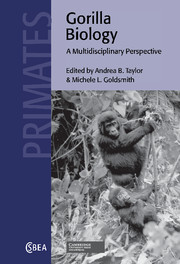Book contents
- Frontmatter
- Contents
- List of contributors
- Acknowledgments
- Epigraph
- Introduction: Gorilla biology: Multiple perspectives on variation within a genus
- Part 1 Gorilla taxonomy and comparative morphology
- 1 An introductory perspective: Gorillas – How important, how many, how long?
- 2 A history of gorilla taxonomy
- 3 Patterns of diversity in gorilla cranial morphology
- 4 The hierarchy of intraspecific craniometric variation in gorillas: A population-thinking approach with implications for fossil species recognition studies
- 5 Morphological differentiation of Gorilla subspecies
- 6 Ontogeny and function of the masticatory complex in Gorilla: Functional, evolutionary, and taxonomic implications
- 7 Intraspecific and ontogenetic variation in the forelimb morphology of Gorilla
- Part 2 Molecular genetics
- Part 3 Behavioral ecology
- Part 4 Gorilla conservation
- Afterword
- Index
- References
3 - Patterns of diversity in gorilla cranial morphology
Published online by Cambridge University Press: 11 August 2009
- Frontmatter
- Contents
- List of contributors
- Acknowledgments
- Epigraph
- Introduction: Gorilla biology: Multiple perspectives on variation within a genus
- Part 1 Gorilla taxonomy and comparative morphology
- 1 An introductory perspective: Gorillas – How important, how many, how long?
- 2 A history of gorilla taxonomy
- 3 Patterns of diversity in gorilla cranial morphology
- 4 The hierarchy of intraspecific craniometric variation in gorillas: A population-thinking approach with implications for fossil species recognition studies
- 5 Morphological differentiation of Gorilla subspecies
- 6 Ontogeny and function of the masticatory complex in Gorilla: Functional, evolutionary, and taxonomic implications
- 7 Intraspecific and ontogenetic variation in the forelimb morphology of Gorilla
- Part 2 Molecular genetics
- Part 3 Behavioral ecology
- Part 4 Gorilla conservation
- Afterword
- Index
- References
Summary
Introduction
Gorillas, perhaps because of their size, always seem to be the subject of spectacularly divergent interpretations. Views of their behavior have ranged from the rapacious, vicious giant ape of the nineteenth century, through Robert Ardrey's (1961) view of them as lethargic, depressed, evolutionary dead ends, to the current view of them as gentle giants, albeit with infanticidal tendencies. Views of gorilla systematics have been no less diverse over the past century and a half (see review by Groves, this volume). Beginning with the initial description of Gorilla gorilla by Savage and Wyman in 1847 through the 1920s, ten separate species of Gorilla were described by systematists from all over the world, often from a single skull. The modern systematics of Gorilla stems from the work of Harold Jefferson Coolidge in 1929. Coolidge reviewed all of the previously described species and provided measurements and graphs of 213 specimens from seven major geographic regions. He placed all gorillas in a single species, Gorilla gorilla, in accordance with others such as Rothschild (1906), Elliot (1913), and Schwarz (1928), but went even further in identifying only two subspecies – Gorilla gorilla gorilla for the gorillas of western and central Africa, and Gorilla gorilla beringei for gorillas from the Virunga mountains and adjacent regions.
More recently, Gorilla systematics has derived almost exclusively from Groves's (1970, 1986; also Groves and Stott, 1979) study of 747 skulls and over 100 skeletons.
- Type
- Chapter
- Information
- Gorilla BiologyA Multidisciplinary Perspective, pp. 35 - 61Publisher: Cambridge University PressPrint publication year: 2002
References
- 1
- Cited by

